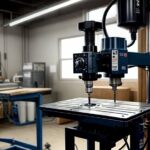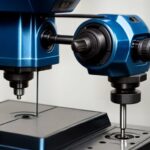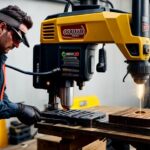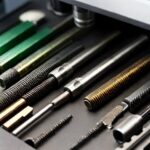Have you ever wondered what that strange component on your drill press that travels up and down while you drill is all about? Thus, no more wondering! The quill is a critical component of a drill press that enables accurate drilling and greater precision.
In this blog article, we’ll examine what a quill is, how it works, and why it’s vital. Understanding the quill and how to use it will help you take your drilling game to the next level, whether you’re a novice or a seasoned DIYer. Now let’s get started and learn about the quill on a drill press.
What is the quill on a drill press?
A drill press’s quill is a vertically moveable spindle that holds the drill bit and provides the mechanism for drilling holes. A cylindrical metal rod connected to the drill press travels up and down inside the press’s head.
The quill provides a sturdy and accurate guide for the drill bit, allowing for precision drilling at different depths. It also enables rapid and simple depth changes, making it a crucial component for drilling activities that demand accuracy and precision.
A lever or handle is commonly used to manipulate the quill, and it may be locked into position to prevent any undesired movement while drilling.
What is quill diameter on a drill press?
The quill diameter on a drill press can vary depending on the specific model and manufacturer. The quill diameter typically ranges from 1 inch to 3 inches for most drill presses. However, larger industrial drill presses may have quill diameters up to 6 inches or more.
The quill diameter is an important factor when choosing a drill press, as it can affect the size of the drill bit that can be used and the maximum drilling depth that can be achieved. It is also important to note that the quill diameter may differ from the chuck capacity, which is the maximum size of the drill bit that the chuck can hold.
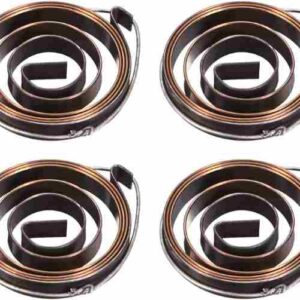 Components of a drill press quill:
Components of a drill press quill:
- Spindle: The spindle is the quill’s primary body that keeps the drill bit in position. It’s usually constructed of steel and precision-machined to guarantee precise drilling.
- The chuck is a clamping device at the spindle’s end that keeps the drill bit in place. Depending on the kind of chuck, it may be tightened or loosened using a key or by hand.
- The feed handle is a lever that allows you to move the quill up and down. It is normally situated on the drill press head’s side and is operated with one hand.
- Depth Stop: A depth stop is a device that enables you to adjust the drilling depth by restricting how far down the quill may go. It is adjustable and lockable to provide constant drilling depth.
- Quill Lock: A quill lock is a device that holds the quill in place while drilling, preventing any undesired movement. It is usually found on the side of the drill press head and is activated or deactivated by turning a knob.
How do I use a drill press quill?
- Ensure your drill press is firmly fixed to the work area and the power cable is connected to a grounded outlet.
- Insert the Drill Bit: Turn the chuck counterclockwise and put the drill bit into it. Turn the chuck clockwise with a key or by hand to tighten it.
- Set the Drilling Depth: Use the knob or lever to adjust the depth stop to the desired depth. Check that the depth stop is firmly fastened.
- Adjust the Quill: Lower the quill with the feed handle until the drill bit is just above the workpiece. The quill should be perpendicular to the surface of the work.
- Drilling begins by turning on the drill press and gradually lowering the quill by rotating the feed lever. Apply consistent pressure to the workpiece and let the drill bit perform. Do not press down on the bit, as this may cause it to shatter or get damaged.
- After you have reached the appropriate drilling depth, elevate the quill by oppositely moving the feed handle. Before withdrawing the drill bit from the workpiece, turn off the drill press and wait for it to come to a full stop.
- Remove the drill bit from the chuck and sweep any trash or shavings off the work area and drill press. Keep the drill bit in a secure place.
Advantages:
- Increased Accuracy and Precision: The quill acts as a sturdy and accurate guide for the drill bit, allowing for precision drilling at different depths. This may aid in the constant size and positioning of holes, which is particularly significant in woodworking, metalworking, and other precision drilling applications.
- Improved Drilling Depth Control: The quill’s depth stop mechanism lets you regulate the drilling depth and guarantee that each hole is drilled to the same depth. This is very beneficial for drilling holes of the same depth as in cabinetry or furniture manufacturing.
- Drilling Errors and Mistakes May Be Reduced: Utilizing a drill press with a quill can assist in decreasing drilling errors and mistakes such as drilling at an angle or going too deep. The quill acts as a steady and constant guide for the drill bit, which may aid in preventing such mistakes.
- Improved Safety: By lowering the chance of harm from a spinning drill bit, using a drill press with a quill may further boost safety. The quill secures the drill bit, preventing it from sliding or flying out of the chuck during usage.
- Drill presses with quills can drill a broad range of hole diameters and depths, making them a flexible tool for various drilling applications. Connecting various attachments to the quill may also be used for other activities like sanding, polishing, and mortising.
Quill maintenance and troubleshooting:
- Clean the Quill regularly: Dust and debris may collect in the quill over time, affecting its function. Clean the quill regularly by wiping it down with a clean cloth and blowing out any dirt using compressed air.
- Lubricate the Quill: Adding lubrication to the quill may help it move smoothly and avoid corrosion. Use a mild machine oil or silicone spray sparingly.
- Examine the Chuck: The chuck on the quill might get worn or broken over time, affecting its capacity to hold the drill bit firmly. Check the chuck on a regular basis for indications of wear or damage, and replace it as needed.
- Examine the Depth Stop: The quill’s depth stop may also get worn or broken, affecting its capacity to keep the quill in place at the correct depth. Check the depth stop regularly for indications of wear or damage, and replace it as needed.
- Solve Quill Issues: If you’re having problems with the quill, such as it not moving smoothly or remaining in position, there might be an issue with the internal mechanics. Examine the quill for indications of wear or damage, and seek additional assistance from the manufacturer’s instructions or professional repair service.
Tips for optimizing the quill’s performance:
- Employ the Correct Drill Bit: Using the correct drill bit for your drilling material will help avoid quill wear and strain and increase performance. For example, a high-speed steel (HSS) drill bit is good for drilling into metal, but a brad-point bit is better suited for wood.
- Employ the Correct Speed: Using the correct speed for the drill bit and material may aid in optimizing quill performance and avoiding drill bit or workpiece damage. See the manufacturer’s instructions or a speed table for suggested speeds for various drill bits and materials.
- Maintain Workpiece Security: Keeping the workpiece secure might assist in preventing the quill from getting misaligned or damaged during drilling. To keep the workpiece firmly in position, use clamps or a vise.
- Change the Quill as Needed: Make modifications to the quill as required to obtain the desired drilling depth and precision, such as raising or lowering it or changing the depth stop.
- Inspect for Wear and Damage: Inspect the quill regularly for indications of wear or damage, such as cracks, chips, or rust. If you find any damage, replace the quill or get it professionally fixed.
Frequently Asked Questions (FAQs)
1. What is the main function of the quill on a drill press?
The main function of the quill on a drill press is to hold the drill bit and provide the mechanism for drilling holes. It allows for precision drilling at different depths and enables rapid and simple depth changes.
2. How does the quill diameter affect my drilling capabilities?
The quill diameter affects the size of the drill bit that can be used and the maximum drilling depth that can be achieved. Larger quill diameters allow for larger drill bits and deeper drilling depths.
3. How can I ensure the quill is functioning properly?
To ensure proper quill function, regularly clean and lubricate the quill, inspect the chuck and depth stop for wear or damage, and address any quill issues by checking for wear or damage in the internal mechanics.
4. Is the quill on a drill press adjustable?
Yes, the quill on a drill press is adjustable. You can raise or lower the quill using the feed handle, and you can also adjust the drilling depth by setting the depth stop.
5. Can I use my drill press for activities other than drilling if it has a quill?
Yes, you can use your drill press for other activities such as sanding, polishing, and mortising by attaching various attachments to the quill.
6. What should I do if my quill is not moving smoothly or staying in position?
If your quill is not moving smoothly or staying in position, there may be an issue with the internal mechanics. Examine the quill for signs of wear or damage and seek additional assistance from the manufacturer’s instructions or a professional repair service.
Last words:
A drill press’s quill is an essential component that plays an important part in drilling precise and accurate holes. Utilizing a drill press with a quill provides various advantages, including higher accuracy and precision, improved drilling depth control, and increased safety.
You can get the most out of your drill press and obtain consistent and dependable results by learning its components, operating it, and maintaining it. You may maintain your quill in excellent working order and improve its performance by following the maintenance and troubleshooting advice described in this blog article.
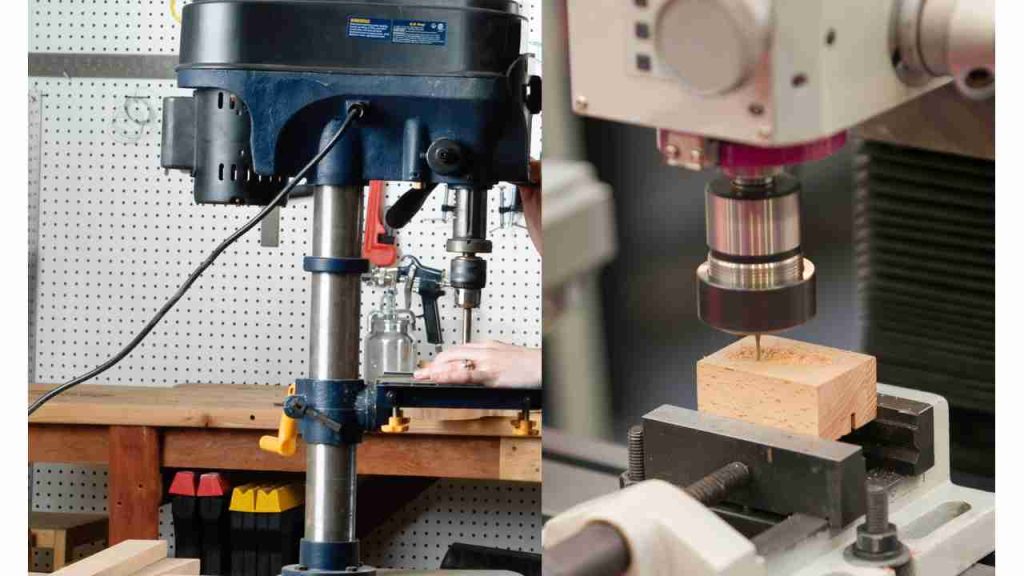
Thus, the next time you use your drill press, remember the value of the quill and utilize it to its best ability to accomplish your drilling objectives.
- Where are WEN drill presses made? - April 2, 2023
- Where are Rikon drill presses made? - April 1, 2023
- Where are Powermatic drill presses made? - April 1, 2023


